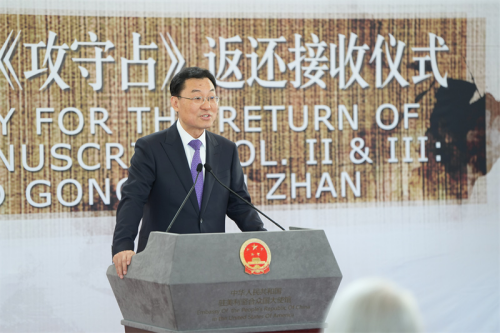
The People’s Republic of China


On May 16, 2025, the Chinese Embassy in the United States hosted a handover ceremony for the return of Chinese cultural relics. China’s National Cultural Heritage Administration received the Zidanku silk manuscript Wuxing Ling and Gongshou Zhan from the National Museum of Asian Art under the Smithsonian Institution. Ambassador Xie Feng spoke at the ceremony, welcoming the return of national treasures to their motherland.

Ambassador Xie noted that lost to foreign lands in times of national weakness, Chinese cultural relics are returning home with the rejuvenation of the Chinese nation. Since 2012, over 2,000 relics have returned. China and the U.S. have made notable progress in heritage cooperation, with around 600 artifacts sent back to China. The return of the Zidanku Silk Manuscript is a cultural milestone for Chinese people and beyond, and a testament to China-U.S. cooperation in heritage preservation, bringing new vitality to people-to-people exchange and friendship.
Ambassador Xie undeerscored that the successful return of the Zidanku silk manuscript reveals that, through dialogue and cooperation based on equality, mutual respect and mutual benefit, the two countries can deliver important and tangible results good for both sides and beyond. The key is to find solutions that serve both sides, and pursue the right path to get along in the new era. This is what the two peoples and the world want to see. It is also a due responsibility for the two major countries.
The Zidanku silk manuscript, excavated in the Chu Tomb located in Zidanku, Changsha in 1942, are the earliest known silk texts and the only ones from China’s Warring States period (475 BC to 221 BC). Lost in 1946, it has great significance to studying ancient Chinese characters, literature and thinking.


